Balance: Inuit Stone Constructions

Inuksuk--Baffin Island
“…art as a behavior…rests on the recognition of a fundamental behavioral tendency that … I call making special….Reality, or what is considered to be reality, is elaborated, reformed, given not only particularity (emphasis on uniqueness, or ‘specialness’) but import (value, or ‘specialness’)—what may be called such things magic or beauty or spiritual power or significance.
Making special implies intent or deliberateness. When shaping or giving artistic expression to an idea, or embellishing an object, or recognizing that an idea or object is artistic, one gives (or acknowledges) a specialness that without one’s activity or regard would not exist. Moreover, one intends by making special to place the activity or artifact in a ‘realm’ different from the everyday. In both functional and nonfunctional art an alternative reality is recognized and entered; the making special acknowledges, reveals, and embodies this reality.” (Ellen Dissanayake, "What is Art For?")

Nunavut Territory, Canada
Imagine an island that lies on the Arctic Circle. The land is tundra--no trees grow here. The line between sky and land is sliver thin. For half of the year, the ground is covered by snow and ice fields; in summer, rock slabs, lichen, berries and a few species of wildflowers and grasses emerge. Mountains make up the interior of the island and travel is often limited to the perimeter.
Although the island is the country’s largest island as well as the world’s fifth largest (just under 184,000 square miles), only 11,000 people live here. This is Baffin Island, Nunavut, located in Northeast Canada. Nunavut is the country’s newest territory and a homeland to an aboriginal people known as Inuit. In their native language of Inuktitut, “Nunavut” means “our land.” “Inuit,” plural for “Inuk,” is the Inuktitut word for “human beings.” The Inuit’s ancestors came from Alaska and Siberia approximately 5,000 years ago. Today, 40,000 live within Canada, one fourth of these on Baffin Island.

Baffin Island_Northeast

Baffin Island, NASA
Until the last few decades of the 20th century, the Inuit lived on Baffin Island as transient hunters/gatherers mush as their ancestors had for thousands of years. All materials to support life (food, clothing, shelter, etc) came from their immediate surroundings and were their responsibility to acquire directly from the source. However, theirs was not a gentle, generous land; this was the arctic tundra. There was no growing of crops or raising livestock. Literally everything that was eaten had to be either picked or hunted and killed. Clothing was made from caribou hides. Shelter was constructed of caribou hides in summer and ice in winter. Theirs was a culture in which their very survival was at the heart of every action. Furthermore, this survival did not allow for a “solid” home. Hunters must follow the food source and the Inuit had to keep moving to live.
In what seems to be a paradox, the Inuit were deeply attached to this harsh landscape. The land not only gave them life, but to the Inuit elders, “the earth was considered a great living being…(with) places of power and objects of veneration that defined the very soul of the world they knew.”
|
|
Baffin Island Inuit legend tells of “Tunniit,” “the ancient ones” who came before the ancestors and prepared the land for the Inuit. Legend also tells us it was the Tunnitt who built the first stone constructions. Oral cultures, such as the early Inuit, did not use written records and depended on verbal and visual communication methods for the telling of cultural knowledge and information. For information within an oral culture to be held in memory, and subsequently passed on, verbal information tended to be highly descriptive while visual information tended to be aesthetically striking so as to viscerally affect the viewer. This was the intention behind Inuit stone constructions. “For the Inummariit--those who lived on the land in the manner of their ancestors--the sinew of their world was the oral tradition, a graphic language made up of stories, images and vital geographic and cultural information that was passed from parent to child, from generation to generation. Within this spare world, one devoid of writing instruments, inuksuit were the material forms of the oral tradition. They created a profile in space.”
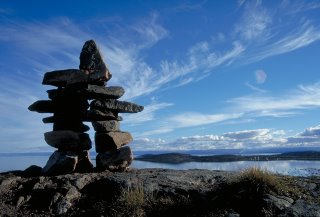 Frobisher Bay, Baffin Island Frobisher Bay, Baffin Island
Inuksuit are the most common form of stone constructions on Baffin Island. The word “inuksuk” (singular of inuksuit) means to “act in the capacity of a human being.” Primarily utilitarian in function, a hand-constructed inuksuk literally stood in the place of the human that built it and conveyed a message from its builder. Norman Hallendy, a man who spent years living with and learning from Inuit elders and families, described his perception of these forms:
“When moving on the land under all sorts of conditions, I regarded a looming inuksuk as I would a protective parent or a beloved teacher. During my travels throughout the Arctic, I came to appreciate these seemingly simple stone constructions as a nuanced and once vital form of communication, a language as rich yet more elementary than the one in which I am communicating now. An inuksuk is a proxy for a human in every sense of the word; it provides comfort to the travel weary, life-saving advice to the disoriented, a focus of veneration to the spiritual seeker. It is a timeless language of the land for a people who existed on the land. As one Inuit elder told me, ‘This attaches me to my ancestors and to this place.’”
As an Inuit’s life is characterized by their nomadic hunting practice, so too is the inuksuk’s message. Inuksuit are highly site-specific. They are constructed to speak of an exact place such as where caribou cross a river or where meat is cached under winter snow. They speak of where fog tends to distort the landscape or where ice tends to float away underfoot. They point in the correct direction of the next camp when there is no sunlight to see the way or where there is a rock overhang for protection when a winter storm unexpectedly catches the hunter, or the preferred spot to land a “qayaq” (kayak).
While there is an assemblage that resembles a window and another that resembles a pointer, the shape of the form does not necessarily allude to a word, phrase, or message. “Instead, they act as mnemonic objects, cues that are a reminder of some condition or particular thing of importance. To truly understand an inuksuk, you need three essential pieces of information. You must record in your mind every detail of the landscape and the objects upon it. You must memorize the location of the places in relation to one another. And you must know the shapes of the inuksuit that are known to your elders, as well as their location and the reason they were put there.”
As an example, Hallendy was offered this travel advice from an elder prior to a trip by boat (note the human characteristics attributed to the inuksuit):
“Traveling along the coast eastward from Kinngait, you will first come upon a inuksuk that from a distance looks like a person walking toward you from where you came. He is particularly helpful in reminding you of the safest way home when the visibility is poor. Farther down the coast, when you reach the first island lying off to your left, you will see an inuksuk made from an old barrel with a stick pointing up from its top. Because this is summer, the inuksuk is only resting (in other words, of little significance). The currents here are very strong, so be sure to stay close to the side where the inuksuk stands. But in spring, if you are traveling on the ice and see this inuksuk at the foot of the island (moved there by previous wayfarers), it means get off the ice at once! You may lose your life by ignoring its message.”
Inuit often speak of Inuksuk in the present tense. Some may have been built hundreds and thousands of years ago, but they continue to stand and speak. As a culture that lives on the edge of the world, the Inuit not only honor, but even more so depend upon the wisdom of the elders who carry their collective cultural knowledge to survive. And as an inuksuk “acts in the capacity of a human being,” its messages are understood as being spoken by an elder. The viewer is “seeing the thoughts of another person left upon the land…”
Inuksuit usually range in size between 18” and 6’ in height. Here are a few Baffin Island inuksuit.
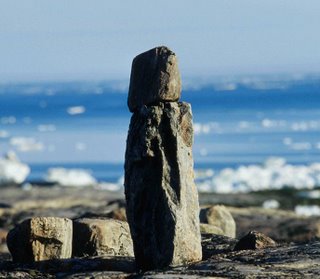
Nappatuq--a single upright stone indicating a direction or a specific spot to be remembered such as a meat cache.
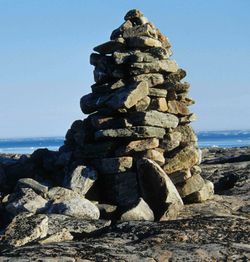
Inuksukjuaq--tended to be larger than average size to be easily seen from a distance; directional aids at headlands or entrances.

Tammariikkuti--the small stone balanced on top determines the function; made by a traveling hunter to tell those who come after him where he has gone.
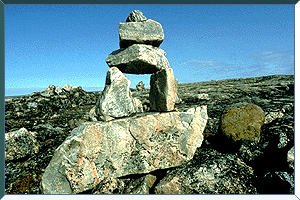

Niungvaliruluit--window shaped for directional use; aligned with a point in the distance or a star.
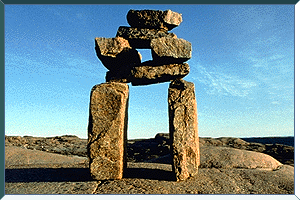
Inuksuapik--known as the most beautiful of inuksuk; indicates joy and gratitude by its maker
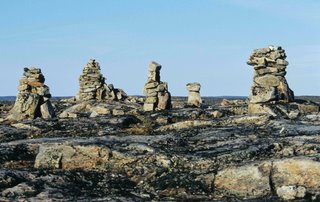
Inuksugalait--one of a few spots throughout the island where multitudes of inuksuit have been placed close to one another. Inuksugalait is a 3-1/2 acre parcel of land on the coast in southwest Baffin Island that contains over two hundred constructions in various sizes and shapes. The site is so ancient that the elders do not know of its original purpose.
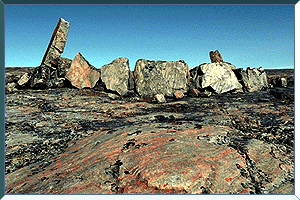
Akitsiraqvik--a sacred Inuit high council site where judgment was rendered and sentences carried out.
~~~~~~~~~~~~
 Not all stone constructions are inuksuk. Those that do not “act in the capacity of human beings” cannot truly be called inuksuk. In fact, a commonly constructed and widely recognized form that is often called an inuksuk is not one. This is the innunguaq, the name of which means “in the likeness of human.” These are constructions that seem to stand with open arms and are intended as symbolic gestures to welcome travelers or show respect for a person who has passed on rather than act in the place of the human. Not all stone constructions are inuksuk. Those that do not “act in the capacity of human beings” cannot truly be called inuksuk. In fact, a commonly constructed and widely recognized form that is often called an inuksuk is not one. This is the innunguaq, the name of which means “in the likeness of human.” These are constructions that seem to stand with open arms and are intended as symbolic gestures to welcome travelers or show respect for a person who has passed on rather than act in the place of the human.
A second non-inuksuk construction is tied to the Inuit’s shamanic spiritual practice. “Spirit” is not an abstraction to the Inuit; there is no separation between the spirit world and their “real” world. The spirits of animals and people are intertwined and live in the rocks and the earth and the sky and the sea. Sacred stone constructions are deeply respected and interaction with these forms are guided by strict cultural customs. “Their spiritual or religious function was rarely divulged. They are a physical manifestation of spiritual power, and many are objects of veneration. Some served to mark the thresholds of spiritual landscape for the Inummariit (the real people), who felt compelled to build them out of love, loneliness or fear.”
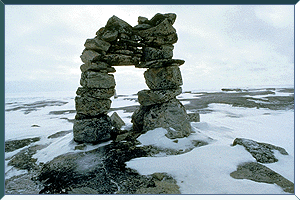 The tupqujaq was a doorway through which shamans, their holy men, entered the spirit world. Other assemblages included the kattaq, two upright stones which marked the path to a sacred object or site; the sakkabluniit, upright stones that were believed to possess spiritual power; and the kibvakattaq, a pyramidal form with a huge boulder perched on top. The tupqujaq was a doorway through which shamans, their holy men, entered the spirit world. Other assemblages included the kattaq, two upright stones which marked the path to a sacred object or site; the sakkabluniit, upright stones that were believed to possess spiritual power; and the kibvakattaq, a pyramidal form with a huge boulder perched on top.
~~~~~~~~~~~~
As Dissanayke’s bioevolutionary theory positioned the arts as an innate human behavior that existed because it was necessary to the evolvement of the human species, so to were the stone constructions of the Inuit necessary to their evolvement. These were people who literally lived on the edge, not only the edge of the thin line between sky and land, but also the thin line between life and death. These constructions are an assertion of their very being-ness within the harshest of environments. The stones stand as balance, a counterweight to forces that would otherwise break a human.
For the Inuit, the way to live in this stark and strikingly beautiful land is to completely embrace it. There is no separation between the spirit world and their “real” world, between the land and themselves, nor between the stone constructions and themselves. Simeonie Quppapik, Hallendy’s longtime Inuit friend and mentor told him, “Look around you…Look at the hills, the sea, the inuksuit everywhere. We are all made of the same stuff. We all possess a spirit, only the way we are arranged temporarily separates us.”
~~~~~~~~~~~~
Today, the use and understanding of the stone constructions is shifting. Inuksuk and inunguaq are rapidly becoming popular cultural artifacts, not only of the Inuit, but of the Nunavut Territory as well as Canada as a whole. Nunavut was officially formed from the eastern part of the Northwest Territory in 1999 in an agreement between the indigenous Inuit and the Canadian government. Granted sovereignty, the Inuit developed their new flag with an inuksuk as a primary symbol.
 Nunavut Flag Nunavut Flag
Over the past few years, an inunguaq that is “called” an inuksuk, has been informally adopted by Canada as a symbol for the entire county. Amid some controversy from native elders, an inuksuk has been chosen as the emblem for the Vancouver Winter Olympics in 2010. Tourist shops now sell little carved inuksuit as well as inuksuk mousepads and shot glasses. On Baffin Island, most Inuit now live in settlements or small towns including Iqaluit, the capital city of Nunavut. In these towns, the newest generation of Inuit travel by snowmobiles with global positioning systems. But they have grown up under the guidance of their elders, both stone and human, and know the stones will outlive them.
~~~~~~~~~~~~
Discussion Question
(I have really enjoyed the questions that have asked us to go back to our own lives to find parallels and so here is one for you…)
Literally and figuratively an inuksuk is an Inuit “touchstone,” a place or an object to which a human can (re)turn for the purposes of grounding and/or guiding oneself. This made me think of my own touchstones--the assorted rocks spread out on my living room mantelpiece that I’ve gathered from various places across the country, the woods I walk within every few weeks, and a photograph of my grandparents listening to the radio on a Sunday afternoon. What are your touchstones? To what do you (re)turn to ground or guide yourself and how do you feel being in this place or with this object?
**All quotes except Dissanayake from Norman Hallendy as found within various sources.
Recommended Reading
Canadian Museum of Civilization Corporation, “Places of Power: Objects of Veneration in the Canadian Arctic.”
Norman Hallendy, Inuksuit: Silent Messengers of the Arctic. Vancouver: Douglas &
McIntyre, 2000.
Mary Wallace, The Inuksuk Book. Toronto: Maple Tree Press, 1999.
Wikipedia, “Baffin Island”
Wikipedia, “Inuksuk”
Photo Credits
(All stone constructions located on Baffin Island, Nunavut, Canada)
Norman Hallendy: “Innunguaq”
Norman Hallendy/Canadian Museum of Civilization Corporation: “Akitsiraqvik,”
“Inuksuapik,” “Niungvaliruluit,” “Tammariikkuti,” “Tupqujak,”
NASA/Wikipedia: “Baffin Island”
Asgar Walk: “Baffin_Island_Northeast,” “Inuksugalait,” “Inuksuk - Baffin Island,”
“Inuksukjuaq,” “Nappatuq,” “Niungvaliruluit 2”
Paul Landry: “Frobisher Bay”
Wikipedia: “Nunavut Flag,” “Nunavut”
|
Labels: Balance: Inuit Stone Constructions
 Inuksuk--Baffin Island
Inuksuk--Baffin Island Nunavut Territory, Canada
Nunavut Territory, Canada Baffin Island_Northeast
Baffin Island_Northeast Baffin Island, NASA
Baffin Island, NASA











